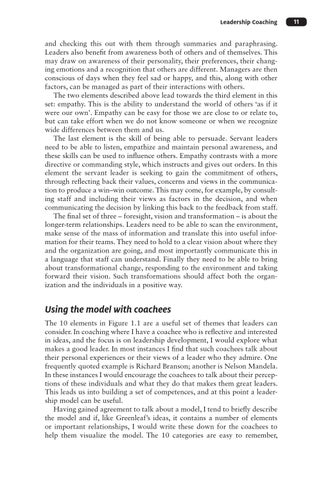Leadership Coaching
11
and checking this out with them through summaries and paraphrasing. Leaders also benefit from awareness both of others and of themselves. This may draw on awareness of their personality, their preferences, their changing emotions and a recognition that others are different. Managers are then conscious of days when they feel sad or happy, and this, along with other factors, can be managed as part of their interactions with others. The two elements described above lead towards the third element in this set: empathy. This is the ability to understand the world of others ‘as if it were our own’. Empathy can be easy for those we are close to or relate to, but can take effort when we do not know someone or when we recognize wide differences between them and us. The last element is the skill of being able to persuade. Servant leaders need to be able to listen, empathize and maintain personal awareness, and these skills can be used to influence others. Empathy contrasts with a more directive or commanding style, which instructs and gives out orders. In this element the servant leader is seeking to gain the commitment of others, through reflecting back their values, concerns and views in the communication to produce a win–win outcome. This may come, for example, by consulting staff and including their views as factors in the decision, and when communicating the decision by linking this back to the feedback from staff. The final set of three – foresight, vision and transformation – is about the longer-term relationships. Leaders need to be able to scan the environment, make sense of the mass of information and translate this into useful information for their teams. They need to hold to a clear vision about where they and the organization are going, and most importantly communicate this in a language that staff can understand. Finally they need to be able to bring about transformational change, responding to the environment and taking forward their vision. Such transformations should affect both the organ ization and the individuals in a positive way.
Using the model with coachees The 10 elements in Figure 1.1 are a useful set of themes that leaders can consider. In coaching where I have a coachee who is reflective and interested in ideas, and the focus is on leadership development, I would explore what makes a good leader. In most instances I find that such coachees talk about their personal experiences or their views of a leader who they admire. One frequently quoted example is Richard Branson; another is Nelson Mandela. In these instances I would encourage the coachees to talk about their perceptions of these individuals and what they do that makes them great leaders. This leads us into building a set of competences, and at this point a leadership model can be useful. Having gained agreement to talk about a model, I tend to briefly describe the model and if, like Greenleaf’s ideas, it contains a number of elements or important relationships, I would write these down for the coachees to help them visualize the model. The 10 categories are easy to remember,
Leadership Coaching_print-ready.indb 11
6/4/2015 11:29:27 AM
